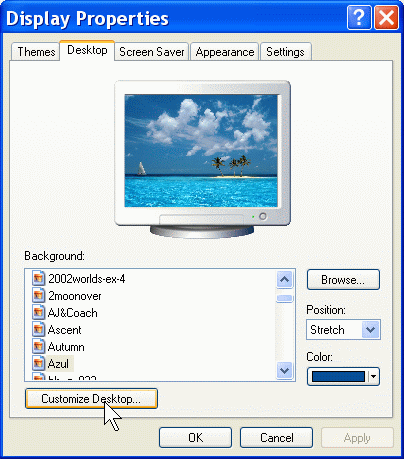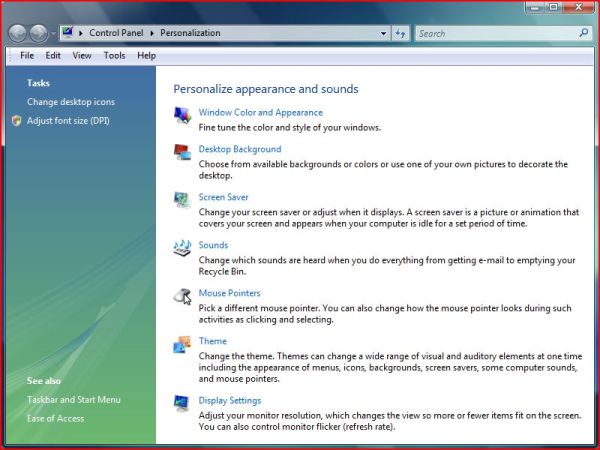Browse All Articles > The Display applet in Windows 7 Control Panel
The Display applet of Windows 7 Control Panel has changed a great deal since Windows XP (it was missing and more or less replaced in Windows Vista by the Personalization applet.) Below is a screenshot of what the Display applet of Windows XP, which you reached through Control Panel or by right clicking the Desktop and selecting Properties, looked like:
![Display Properties in Windows XP]() And here is what appeared in the Personalize applet of Windows Vista, which you could reach by right clicking the Desktop and selecting Personalize from the context menu:
And here is what appeared in the Personalize applet of Windows Vista, which you could reach by right clicking the Desktop and selecting Personalize from the context menu:
![Personalization of Vista Control Panel]() Note that the Personalization applet of Vista's Control Panel allowed you to perform customization functions that were controlled in Windows XP by different tabs of the XP Display applet, such as change your Desktop Background, modify screen saver settings, and use different Themes. The things that you modified by clicking on the Appearance tab in XP are controlled in Vista by clicking on the link for Window Color and Appearance, then in the next window that appears (called Appearance Settings) click on the button labeled Advanced. But in this case you get a message saying "Colors and sizes selected here apply only if you have selected a Windows Classic color scheme."
Note that the Personalization applet of Vista's Control Panel allowed you to perform customization functions that were controlled in Windows XP by different tabs of the XP Display applet, such as change your Desktop Background, modify screen saver settings, and use different Themes. The things that you modified by clicking on the Appearance tab in XP are controlled in Vista by clicking on the link for Window Color and Appearance, then in the next window that appears (called Appearance Settings) click on the button labeled Advanced. But in this case you get a message saying "Colors and sizes selected here apply only if you have selected a Windows Classic color scheme."
By means of Themes you could make simultaneous modification of several elements of Windows operation such as Background, Screensaver, Sounds, appearance of menus, Mouse pointers, and icons. Windows XP also had Themes, as well as separate Control Panel applets for Sounds and Mouse.
In Windows 7, you still have the Personalization applet in Control Panel which allows the same customization functions as Vista, but you also have a new Display applet there. A screenshot of what it looks like appears below:
![Display applet in Windows 7 Control Panel]()
There are many things you can do to change what is displayed in Windows 7 by means of this applet. For instance, you can adjust the resolution of your display device, and adjust the brightness, as shown in the following screenshot:
![Adjust Display Resolution in Windows 7]() Windows Vista and XP also had capabilities for adjusting screen resolution.
Windows Vista and XP also had capabilities for adjusting screen resolution.
You can also calibrate the color settings of your monitor, as shown below:
![Color Calibration in Windows 7]() Neither Vista nor XP had color calibration built into their Control Panels. You needed to either manually adjust external settings on your monitor or run non-Windows calibration software.
Neither Vista nor XP had color calibration built into their Control Panels. You needed to either manually adjust external settings on your monitor or run non-Windows calibration software.
You can set a custom text size by modifying the DPI (Dots Per Inch) setting:
![Custom DPI Setting in Windows 7]() Windows Vista and XP also allowed modifying of the DPI setting, but only between the two values of 96 and 120. Windows 7 allows four different percentage amounts of "normal size": 100 (96 dpi), 125 (120 dpi), 150 (144 dpi), and 200 (192 dpi).
Windows Vista and XP also allowed modifying of the DPI setting, but only between the two values of 96 and 120. Windows 7 allows four different percentage amounts of "normal size": 100 (96 dpi), 125 (120 dpi), 150 (144 dpi), and 200 (192 dpi).
There are some illustrated tutorials on using the new Display applet of Windows 7 Control Panel at these pages on the net:
http://www.sevenforums.com/tutorials/5823-display-color-calibration.html
http://www.sevenforums.com/tutorials/255-screen-resolution-display-settings.html
http://www.sevenforums.com/tutorials/258-color-bit-depth-display-settings.html
http://www.sevenforums.com/tutorials/256-screen-refresh-rate-display-settings.html
If you cannot see the screenshots in the tutorials above, just find the link for becoming a member of the forum and use it to join -- it's free.
 And here is what appeared in the Personalize applet of Windows Vista, which you could reach by right clicking the Desktop and selecting Personalize from the context menu:
And here is what appeared in the Personalize applet of Windows Vista, which you could reach by right clicking the Desktop and selecting Personalize from the context menu:
 Note that the Personalization applet of Vista's Control Panel allowed you to perform customization functions that were controlled in Windows XP by different tabs of the XP Display applet, such as change your Desktop Background, modify screen saver settings, and use different Themes. The things that you modified by clicking on the Appearance tab in XP are controlled in Vista by clicking on the link for Window Color and Appearance, then in the next window that appears (called Appearance Settings) click on the button labeled Advanced. But in this case you get a message saying "Colors and sizes selected here apply only if you have selected a Windows Classic color scheme."
Note that the Personalization applet of Vista's Control Panel allowed you to perform customization functions that were controlled in Windows XP by different tabs of the XP Display applet, such as change your Desktop Background, modify screen saver settings, and use different Themes. The things that you modified by clicking on the Appearance tab in XP are controlled in Vista by clicking on the link for Window Color and Appearance, then in the next window that appears (called Appearance Settings) click on the button labeled Advanced. But in this case you get a message saying "Colors and sizes selected here apply only if you have selected a Windows Classic color scheme."
By means of Themes you could make simultaneous modification of several elements of Windows operation such as Background, Screensaver, Sounds, appearance of menus, Mouse pointers, and icons. Windows XP also had Themes, as well as separate Control Panel applets for Sounds and Mouse.
In Windows 7, you still have the Personalization applet in Control Panel which allows the same customization functions as Vista, but you also have a new Display applet there. A screenshot of what it looks like appears below:
There are many things you can do to change what is displayed in Windows 7 by means of this applet. For instance, you can adjust the resolution of your display device, and adjust the brightness, as shown in the following screenshot:
You can also calibrate the color settings of your monitor, as shown below:
You can set a custom text size by modifying the DPI (Dots Per Inch) setting:
There are some illustrated tutorials on using the new Display applet of Windows 7 Control Panel at these pages on the net:
http://www.sevenforums.com/tutorials/5823-display-color-calibration.html
http://www.sevenforums.com/tutorials/255-screen-resolution-display-settings.html
http://www.sevenforums.com/tutorials/258-color-bit-depth-display-settings.html
http://www.sevenforums.com/tutorials/256-screen-refresh-rate-display-settings.html
If you cannot see the screenshots in the tutorials above, just find the link for becoming a member of the forum and use it to join -- it's free.
Have a question about something in this article? You can receive help directly from the article author. Sign up for a free trial to get started.

Comments (0)